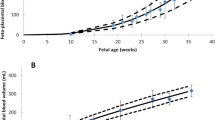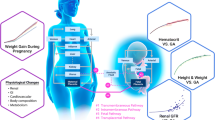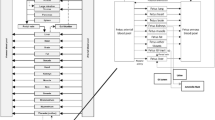Summary
Maternal and fetal plasma differ in their concentrations of the important drug binding plasma proteins, albumin and α1acid glycoprotein, with albumin being slightly more concentrated in fetal plasma, and α1-acid glycoprotein being only 37% of the maternal concentration at term. In general, these differences relate linearly to the bound to free concentration ratio of drugs associated with these proteins. Although only the free concentration is generally considered to be the pharmacologically active form, these differences can dramatically affect the total concentration and relative distribution of drugs between maternal and fetal plasma.
In order to test our hypothesis that plasma protein binding is the major determinant of fetal/maternal drug distribution at steady-state, we examined whether fetal binding could be predicted from adult binding information. Data from studies of maternal, plasma protein binding were used to predict fetal plasma protein binding based solely on the differences in protein concentrations. These predictions were compared with observed fetal binding data. This analysis showed a slope near unity and a high correlation (r2 = 0.900) which implies that there are no significant differences between the binding affinities of these proteins. A similar analysis performed using data on drug binding in non-pregnant adults gave an r2 or 0.971.
Having established that fetal plasma proteins bind drugs similarly to their maternal counterparts, fetal/maternal plasma drug concentration ratios (F/M) were predicted for various drugs using information from literature on the drug’s adult plasma protein binding, the protein to which it binds, and the fetal and maternal plasma concentrations of that binding protein. This information was compared with data from studies which observed the fetal/maternal plasma concentration ratio of these drugs at steady-state. The observed F/M ratio was correlated with the predicted F/M values for the 35 drugs (r2 = 0.473, p < 10−5. When considering only studies done at term the correlation coefficient increased to 0.558. This analysis was subject to the limitations of comparing mean data from different studies.
The fact that nearly half or more of the variability of the transplacental drug concentration ratios at steady-state is explainable by the plasma protein concentration gradient, despite between-study variability, leads us to conclude that it is the most significant factor in establishing the F/M ratio at steady-state.
Similar content being viewed by others
References
Allonen H, Kanto J, Iisalo E. The foetal-maternal distribution of digoxin in early human pregnancy. Acta Pharmacologica et Toxicologica 39: 477–480, 1976
Anderson DF, Phernetton TM, Rankin JHG. Prediction of fetal drug concentrations. American Journal of Obstetrics and Gynecology 137: 735–738, 1980
Asali LA, Brown KF. Naloxone protein binding in adult and foetal plasma. European Journal of Clinical Pharmacology 27: 459–463, 1984
Ballard PL, Granberg P, Ballard A. Glucocorticoid levels in maternal and cord serum after prenatal betamethasone therapy to prevent respiratory distress syndrome. Journal of Clinical Investigation 56: 1548–1554, 1975
Belpaire FM, Bogaert MG, Rosseneu M. Binding of β-adrenoceptor blocking drugs to human serum albumin, α1-acid glycoprotein and to human serum. European Journal of Clinical Pharmacology 22: 253–256, 1982
Bergogne-Berezin E, Bryskier A, Berthelot G, Ravina JH, Vernant D. Placental transfer of cefmenoxime in late pregnancy. Chemotherapy 31: 1–5, 1985
Bredesen JE, Pike E, Lunde PKM. Plasma binding of disopyramide and mono-N-dealkyldisopyramide. British Journal of Clinical Pharmacology 14: 673–676, 1982
Brers O, Nilsen OG, Sager G, Sandnes D, Jacobsen S. Influence of pH and buffer type on drug binding in human serum. Clinical Pharmacokinetics 9 (Suppl. l): 85–86, 1984
Chen S-S, Perucca E, Lee JN, Richens A. Serum protein binding and free concentration of phenytoin and phenobarbital in pregnancy. British Journal of Clinical Pharmacology 13: 547–554, 1982
Chu CY-T, Singla VP, Wang H-P, Sweet B, Lai LT-Y. Plasma alpha1-acid glycoprotein levels in pregnancy. Clinica Chimica Acta 112: 235–240, 1981
Crawford JS, Hooi HWY. Binding of bromsulphthalein by serum albumin from pregnant women, neonates, and subjects taking oral contraceptives. British Journal of Anaesthesia 40: 723–729, 1968a
Crawford JS, Hooi HWY. Binding of salicylic acid and sulphanilimide in serum from pregnant patients, cord blood, and subjects taking oral contraceptives. British Journal of Anaesthesia 40: 825–833, 1968b
Ehrnebo M, Agurell S, Jalling B, Boreus LO. Age differences in drug binding to plasma proteins: studies on human foetuses, neonates, and adults. European Journal of Clinical Pharmacology 3: 189–193, 1971
Feely GR, Wilkinson CB, McAllister CB, Wood AJJ. Increased toxicity and reduced clearance of lidocaine by cimetidine. Annals of Internal Medicine 96: 592–594, 1982
Gamble JAS, Moore J, Lamki H, Howard PJ. A study of plasma diazepam levels in mother and infant. British Journal of Obstetrics and Gynaecology 84: 588–591, 1977
Ghonheim MM, Kortilla K. Pharmacokinetics of intravenous anaesthetics. Clinical Pharmacokinetics 2: 344–372, 1977
Gilman AG, Goodman LS, Rail TW, Murad F (Eds). Goodman and Gilman’s The pharmacological basis of therapeutics, 7th ed., Macmillan Publishing Company, 1985
Gordon HR. Fetal bradycardia after paracervical block. Correlation with fetal and maternal blood levels of local anesthetic (mepivacaine). New England Journal of Medicine 279: 910–914, 1968
Gorodischev R, Krasner J, Yaffe SJ. Serum protein binding of digoxin in newborn infants. Research Communications in Chemical Pathology and Pharmacology 9: 387–390, 1974
Greenblatt DJ. Clinical pharmacokinetics of oxazepam and lorazepam. Clinical Pharmacokinetics 6: 89–105, 1981
Hamar C, Levy G. Serum protein binding of drugs and bilirubin in newborn infants and their mothers. Clinical Pharmacology and Therapeutics 28: 58–63, 1980
Haram K, Augensen K, Elsayed S. Serum protein pattern in normal pregnancy with special reference to acute phase reactants. British Journal of Obstetrics and Gynaecology 90: 139–145, 1983
Heimann G. Drug disposition during the perinatal period. Biological Research in Pregnancy and Perinatology 2: 1–14, 1981
Henry JA, Mitchell SN. Effect of pH on human plasma protein binding of a series of β-adrenoceptor antagonists. British Journal of Clinical Pharmacology 11: 119P–120P, 1981
Herngren L, Ehrnebo M, Boréus LO. Drug binding to plasma proteins during human pregnancy and in the perinatal period: studies on cloxacillin and alprenolol. Developmental Pharmacology and Therapeutics 6: 110–124, 1983
Howe JP, McGowan WAW, Moore J, McCaughey W, Dundee JW. The placental transfer of cimetidine. Anaesthesia 36: 371–375, 1981
Kangas L, Breimer DD. Clinical pharmacokinetics of nitrazepam. Clinical Pharmacokinetics 6: 346–366, 1981
Kangas L, Erkkola R, Kanto J, Eronen M. Transfer of free and conjugated oxazepam across the human placenta. European Journal of Clinical Pharmacology 17: 301–304, 1980
Kangas L, Kanto J, Erkkola R. Transfer of nitrazepam across the human placenta. European Journal of Clinical Pharmacology 12: 355–357, 1977
Kanto J. Obstetric analgesia. Clinical pharmacokinetic considerations. Clinical Pharmacokinetics 11: 283–298, 1986
Kanto J, Aaltonen L, Liukko P, Mäenpää K. Transfer of lorazepam and its conjugate across the human placenta. Acta Pharmacologica et Toxicologica 47: 130–134, 1980
Kivalo I, Saarikoski S. Placental transmission of atropine at full-term pregnancy. British Journal of Anaesthesia 49: 1017–1021, 1971
Kornguth ML, Hutchins LG, Eichelman BS. Binding of psychotropic drugs to isolated α1-acid glycoprotein. Biochemical Pharmacology 30: 2435–2441, 1981
Kouchenour NK, Emilky MG, Sawchuk RJ. Phenytoin metabolism in pregnancy. Obstetrics and Gynecology 56: 577–582, 1980
Kragh-Hansen U. Molecular aspects of ligand binding to serum albumin. Pharmacological Reviews 33: 17–53, 1981
Krasner J, Giacoia GP, Yaffe SJ. Drug-protein binding in the newborn infant. Annals of the New York Academy of Sciences 226: 101–114, 1973
Krauer B, Dayer P, Anner R. Changes in serum albumin and α1-acid glycoprotein concentrations during pregnancy: an analysis of fetal-maternal pairs. British Journal of Obstetrics and Gynaecology 91: 875–881, 1984
Krauer B, Krauer F, Hytten FE. Drug disposition and pharmacokinetics in the maternal-placental-fetal unit. Pharmacology and Therapeutics 10: 301–328, 1980
Krauer B, Nau H, Dayer P, Bischof P, Anner R. Serum protein binding of diazepam and propranolol in the feto-maternal unit from early to late pregnancy. British Journal of Obstetrics and Gynaecology 93: 322–328, 1986
Kuhnz W, Koch S, Jakob S, Hartmann A, Helge H, et al. Ethosuximide in epileptic women during pregnancy and lactation period: placental transfer, serum concentrations in nursed infants and clinical status. British Journal of Clinical Pharmacology 18: 671–677, 1984
Kwong TC. Free drug measurements: methodology and clinical significance. Clinica Chimica Acta 151: 193–216, 1985
Levy G, Hayton WL. Pharmacokinetic aspects of placental drug transfer. In Boréus L (Ed.) Fetal pharmacology, pp. 29–39, Raven Press, New York, 1973
Martinez G, Snyder RD. Transplacental passage of primidone. Neurology 23: 381–383, 1973
Meuldermans W, Woestenborghs R, Noordiun H, Camu F, van Steenberge A, et al. Protein binding of the analgesics alfentanil and sufentanil in maternal and neonatal plasma. European Journal of Clinical Pharmacology 30: 217–219, 1986
Mirkin BL. Perinatal pharmacology: placental transfer, fetal localization, and neonatal disposition of drugs. Anesthesiology 43: 156–170, 1975
Morgan DJ, Blackman GL, Pauli JD, Wolf JL. Pharmacokinetics and plasma binding of thiopental, II: studies at caesarean section. Anesthesiology 54: 474–480, 1981
Morishima HO, Daniel SS, Finster M, Poppers PJ, James LS. Transmission of mepivacaine hydrochloride (Carbocaine) across the human placenta. Anesthesiology 27: 147–154, 1966
Nation RL. Meperidine binding in maternal and fetal plasma. Clinical Pharmacology and Therapeutics 29: 472–479, 1980
Nau H. Clinical pharmacokinetics in pregnancy and perinatology. I. Placental transfer and fetal side effects of local anaesthetic agents. Developmental Pharmacology and Therapeutics 8: 149–181, 1985
Nau H, Krauer B. Serum protein binding of valproic acid in fetus-mother pairs throughout pregnancy: correlation with oxytocin administration and albumin and free fatty acid concentrations. Journal of Clinical Pharmacology 26: 215–221, 1986
Nau H, Kuhnz W, Egger H-J, Rating DA, Helge H. Anticonvulsants during pregnancy and lactation: transplacental, maternal and neonatal pharmacokinetics. Clinical Pharmacokinetics 7: 508–543, 1982
Nau H, Luck W, Kuhnz W. Decreased serum protein binding of diazepam and its major metabolite in the neonate during the first postnatal week relate to increased free fatty acid levels. British Journal of Clinical Pharmacology 17: 92–98, 1984
Nau H, Luck W, Kuhnz W, Wegener S. Serum protein binding of diazepam, desmethyldiazepam, furosemide, indomethacin, warfarin, and phenobarbital in human fetus, mother, and newborn infant. Pediatric Pharmacology 3: 219–227, 1983
Nau H, Rating D, Hä user I, Jäeger E, Koch S, et al. Placental transfer and pharmacokinetics of primidone and its metabolites phenobarbital, PEMA, hydroxyphenobarbital in neonates and infants of epileptic mothers. European Journal of Clinical Pharmacology 18: 31–42, 1980
Nau H, Rating D, Koch S, Hä user I, Helge H. Valproic acid and its metabolites: placental transfer, neonatal pharmacokinetics, transfer via mother’s milk and clinical status in neonates of epileptic mothers. Journal of Pharmacology and Experimental Therapeutics 219: 768–777, 1981
Needs CJ, Brooks PM. Clinical pharmacokinetics of the salicylates. Clinical Pharmacokinetics 10: 164–177, 1985
Notarianni LJ. Placental transfer of pethidine and bupivacaine. Neuropharmacology 20: 1253–1258, 1981
Olsen GD, Chan EM, Riker WK. Binding of d-tubocurarine di [methyl-14C] ether iodide and other amines to cartilage, chondritin sulfate, and human plasma proteins. Journal of Pharmacology and Experimental Therapeutics 195: 242–250, 1975
Onnen I, Barrier G, d’Athis Ph, Sureau C, Olive G. Placental transfer of atropine at the end of pregnancy. European Journal of Clinical Pharmacology 15: 443–446, 1979
Osathomondh R, Tulchinsky D, Kamali H, Fencl MD, Taeusch HW. Dexamethasone levels in pregnant women and newborn infants. Journal of Pediatrics 90: 617–620, 1977
Pacifici GM, Cuoci L, Guarneri M, Fornaro P, Arcidiacno G, et al. Placental transfer of pinazepam and its metabolite n-des-methyldiazepam in women at term. European Journal of Clinical Pharmacology 27: 307–310, 1984a
Pacifici GM, Tadeucci-Brunelli G, Rane A. Clonazepam serum protein binding during development. Clinical Pharmacology and Therapeutics 35: 354–359, 1984b
Paxton JW. Alpha1-acid glycoprotein and binding of basic drugs. Methods and Findings in Experimental and Clinical Pharmacology 5: 635–648, 1983
Paxton JW, Calder RL. Propranolol binding in serum: comparison of methods and investigation of effects of drug concentration, pH, and temperature. Journal of Pharmacological Methods 10: 1–11, 1983
Peck CC, Sheiner LB, Nichols AI. The problem of choosing weights in nonlinear regression analysis of pharmacokinetic data. Drug Metabolism Reviews 15: 133–148, 1984
Peets EA, Staub M, Symchowicz S. Plasma binding of betamethasone-3H, dexamethasone-3H, and cortisol-l4C: a comparative study. Biochemical Pharmacology 18: 1655–1663, 1969
Peiker G, Traeger A. Placental passage of nalidixic acid (Negram) and pharmacokinetic studies in the newborn infant. Pharmazie 38: 613–615, 1983
Perucca E, Crema A. Plasma protein binding of drugs in pregnancy. Clinical Pharmacokinetics 7: 336–352, 1982
Petersdorf RG, Adams RD, Braunwald E, Isselbacher KJ, Martin JB, et al. (Eds). Harrison’s principles of internal medicine, 10th ed., p. 1781, McGraw-Hill, Inc., 1983
Petersen MC, Collier CB, Ashley JJ, McBride WG, Nation RL. Disposition of betamethasone in parturient women after intravenous administration. European Journal of Clinical Pharmacology 25: 803–810, 1983
Petersen MC, Moore RG, Nation RL. Relationship between the transplacental gradients of bupivacaine and c1-acid glycoprotein. British Journal of Clinical Pharmacology 12: 859–862, 1981
Petersen MC, Nation RL, Ashley JJ, McBride WG. The placental transfer of betamethasone. European Journal of Clinical Pharmacology 18: 245–247, 1980
Philip AGS, Hewitt JR. α1-Acid glycoprotein in the neonate with and without infection. Biology of the Neonate 43: 118–124, 1983
Philipson A. Pharmacokinetics of antibiotics in pregnancy and labour. Clinical Pharmacokinetics 4: 297–309, 1979
Piafsky KM, Borgå O. Plasma protein binding of basic drugs, II: importance of α1-acid glycoprotein for interindividual variation. Clinical Pharmacology and Therapeutics 22: 545–548, 1977
Piafsky KM, Woolner EA. The binding of basic drugs to α1-acid glycoprotein in cord serum. Journal of Pediatrics 100: 820–822, 1982
Pike E, Skuterud B, Kierulf P, Bredesen JE, Lunde PKM. The relative importance of albumin, lipoproteins, and orosomucoid for drug serum binding. Clinical Pharmacokinetics 9 (Suppl. 1): 84–85, 1984
Pruitt AW, Dayton PG. A comparison of the binding of drugs to adult and cord plasma. European Journal of Clinical Pharmacology 4: 59–62, 1971
Pynnönen S, Kanto J, Sillanpää M, Erkkola R. Carbamazepine: placental transport, tissue concentrations in the foetus and newborn, and level in milk. Acta Pharmacologica et Toxicologica 41: 244–253, 1977
Rane A, Lunde PKM, Jalling B, Yaffe SJ, Sjöqvist F. Plasma protein binding of diphenylhydantoin in normal and hyperbilirubinemic infants. Journal of Pediatrics 78: 877–882, 1971
Reboud P, Goulade J, Groslambert P, Colomb M. The influence of normal pregnancy and the postpartum state on plasma proteins and lipids. American Journal of Obstetrics and Gynecology 86: 820–828, 1963
Ridd MJ, Brown KF, Nation RL, Collier CB. Differential transplacental binding of diazepam: causes and implications. European Journal of Clinical Pharmacology 24: 595–601, 1983
Shnider SM, Way EL. The kinetics of transfer of lidocaine (Xylocaine) across the human placenta. Anesthesiology 29: 944–950, 1968
Simon C, Still W, Wilkinson PJ. (Eds). Antibiotic Therapy in Clinical Practice, FK Schattauer Verlag, Stuttgart, 1981
Somogyi A, Gugler R. Clinical pharmacokinetics of cimetidine. Clinical Pharmacokinetics 8: 463–495, 1983
Song CS, Merkatz IR, Rifkind AB, Gillete PN, Kappas A. The influence of pregnancy and oral contraceptive steroids on the concentration of plasma proteins. American Journal of Obstetrics and Gynecology 108: 227–231, 1970
Svensson CK, Woodruff MN, Baxter JG, Lalka D. Free drug concentration monitoring in clinical practice: rationale and current status. Clinical Pharmacokinetics 11: 450–469, 1986
Thomas J, Long G, Morgan D. Plasma protein binding and placental transfer of bupivacaine. Clinical Pharmacology and Therapeutics 19: 426–434, 1976
Thompson GA, Myers JA, Turner PA, Denson DA, Coyle DE, et al. Influence of cimetidine on bupivacaine disposition in rat and monkey. Drug Metabolism and Disposition 12: 625–630, 1984
Tomson G, Garle M, Thalme B, Nisell H, Nylund L, et al. Maternal kinetics and transplacental passage of pethidine during labour. British Journal of Clinical Pharmacology 13: 653–659, 1982
Tsuei SE, Petersen MC, Ashley JJ, McBride WG, Moore RG. Disposition of synthetic glucocorticoids, II: dexamethasone in parturient women. Clinical Pharmacology and Therapeutics 28: 88–98, 1980
Tucker GT, Boyes RN, Bridenbaugh PO, Moore DC. Binding of anilide-type local anaesthetics in human plasma, II: implications in vivo, with special reference to transplacental distribution. Anesthesiology 33: 304–314, 1970
Virtanen R, Kanto J, Iisalo E, Iisalo EUM, Salo M, et al. Pharmacokinetic studies with atropine with special reference to age. Acta Anaesthesiologica Scandinavica 26: 297–300, 1982
Waddell WJ, Marlowe C. Transfer of drugs across the placenta. Pharmacology and Therapeutics 14: 375–390, 1981
Wallace S. Altered plasma albumin in the newborn infant. British Journal of Clinical Pharmacology 14: 82–85, 1977
Wood M, Wood AJJ. Changes in plasma drug binding and α1 acid glycoprotein in mother and newborn infant. Clinical Pharmacology and Therapeutics 29: 522–526, 1981
Yerby MS, Friel PN, Miller DQ. Carbamazepine protein binding and disposition in pregnancy. Therapeutic Drug Monitoring 7: 269–273, 1985
Author information
Authors and Affiliations
Rights and permissions
About this article
Cite this article
Hill, M.D., Abramson, F.P. The Significance of Plasma Protein Binding on the Fetal/Maternal Distribution of Drugs at Steady-State. Clin-Pharmacokinet 14, 156–170 (1988). https://doi.org/10.2165/00003088-198814030-00004
Published:
Issue Date:
DOI: https://doi.org/10.2165/00003088-198814030-00004




